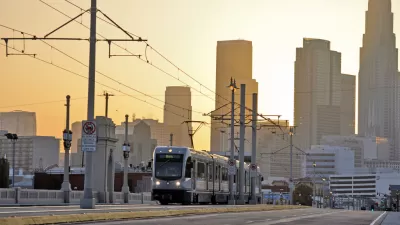By comparing the city's density, scale, and distribution of employment nodes to other major cities, Kristin Eberhard makes the case for why and how transit can work in big, dense, polycentric Los Angeles.
"LA faces a public transit challenge," says Eberhard. "How to connect a disperse, evenly dense population with multiple jobs centers and residential areas in a seamless way that is competitive with cars? My answer: we can’t just do what other cities do and hope for the best."
She details how L.A.'s structure compares to other transit rich cities, and explains the three key attributes for building an effective public transit system for the city:
- We need a grid, not a spiderweb: "LA needs to cover a broad territory fairly evenly so that residents can get not just to a single downtown destination, but pretty much everywhere in the region."
-
We need better first-mile / last-mile solutions: "Most people walk to transit, so streets need to be walkable, but they also need to be bikable, scooterable, and neighborhood EV-able (speed-limited to 25 mph so that it is only suitable for neighborhood streets) to really give everyone a good option."
-
We need to have an ecosystem of options: "A combination of carpooling, biking, taking the bus, or driving an EV to a transit hub could vastly improve LA's transportation problems. LA’s solution needs to create an ecosystem where everyone has many options."
FULL STORY: How can transit work in big, dense, polycentric Los Angeles?

Alabama: Trump Terminates Settlements for Black Communities Harmed By Raw Sewage
Trump deemed the landmark civil rights agreement “illegal DEI and environmental justice policy.”

Planetizen Federal Action Tracker
A weekly monitor of how Trump’s orders and actions are impacting planners and planning in America.

The 120 Year Old Tiny Home Villages That Sheltered San Francisco’s Earthquake Refugees
More than a century ago, San Francisco mobilized to house thousands of residents displaced by the 1906 earthquake. Could their strategy offer a model for the present?

LA’s Tree Emergency Goes Beyond Vandalism
After a vandal destroyed dozens of downtown LA trees, Mayor Karen Bass vowed to replace them. Days later, she slashed the city’s tree budget.

Sacramento Leads Nation With Bus-Mounted Bike Lane Enforcement Cameras
The city is the first to use its bus-mounted traffic enforcement system to cite drivers who park or drive in bike lanes.

Seattle Voters Approve Social Housing Referendum
Voters approved a corporate tax to fund the city’s housing authority despite an opposition campaign funded by Amazon and Microsoft.
Urban Design for Planners 1: Software Tools
This six-course series explores essential urban design concepts using open source software and equips planners with the tools they need to participate fully in the urban design process.
Planning for Universal Design
Learn the tools for implementing Universal Design in planning regulations.
Ada County Highway District
Clanton & Associates, Inc.
Jessamine County Fiscal Court
Institute for Housing and Urban Development Studies (IHS)
City of Grandview
Harvard GSD Executive Education
Toledo-Lucas County Plan Commissions
Salt Lake City
NYU Wagner Graduate School of Public Service





























